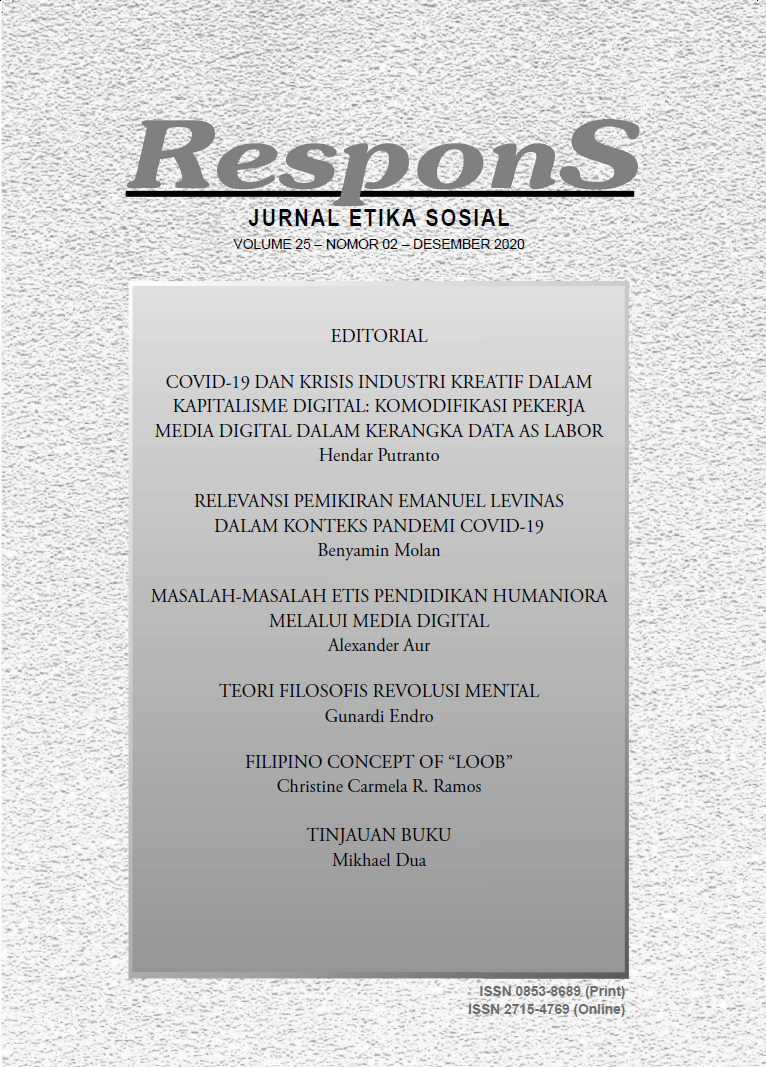Filipino Concept of “Loob”
DOI:
https://doi.org/10.25170/respons.v25i02.2467Keywords:
Loob, loob as holistic, loob as interior, personalismAbstract
The paper discussed Filipino indigenous thoughts to appreciate its culture. “Loob” encompassed Filipinos’ humanity, personality, theological perspective and daily experiences. It aspired harmony with others and nature to be in union with God. The interpersonalistic characteristic of “loob” explained the dualism in body-soul and emotional-rational of the Filipinos. The paper focused on the two dimensions of “loob”: as interior and holistic. The interior “loob” affirmed the innate goodness. “Loob” is reconstructed not only the world but itself as well. The holistic concept referred to the unified entity of the world, the non-dual outlook of the world. More, the author took note of the interplay of emerging contrasts between the views of Ayn Rand and the Filipino concept of “loob”. While the Western philosophy emphasizes modern science and technology, the Eastern thinking, however, is more concerned on the inner and personal nature of the self. The Western thinking is departmentalized and detached. On the other hand, the Eastern thinking views the world of senses as ephemeral and illusory. Likewise, the Eastern thinker is acquainted through one’s personal experience and intuitive grasp of reality which is of higher value than analytical speculation
References
Alejo, A. (1990). Tao po! Tuloy kayo! Manila. Ateneo de Manila University.
Andres, T. (1986). Management by Filipino values. Manila. Values and Management center.
Church, T. 1986. Filipino personality: A review of research and writings. Manila. DLSU press.
Copplestone, F. (1980). Philosophies and culture. Oxford. Oxford University Press.
Dy, M. (1989). Mga babasahin sa pilosopiya. Manila. Goodwill Trading Co. Inc.
Fromm, E. (1957). The art of loving. London. Unwin books.
________________.1973. Anatomy of human destructiveness. California. Holt, Rinehart and Winston.
Gorospe, V. (1988). Filipino values revisited. Manila. National bookstore.
Johnston, W. (1973). The cloud of unknowing. New York. Image Books.
Mclean, G. (1970). Philosophy and Christian theology. Belgium. Cultural press.
Mercado, D. (1974). Elements of Filipino philosophy. Tacloban city. Divine Word Publications.
Pourrat, P. (1953). Christian spirituality in the middle ages. New York. The Newman Press.
Rand, A. (1946). Anthem. Idaho. Caxton Printers Ltd.
______. (1946). Capitalism: An unknown ideal. New York. New American Ltd
______. (1961). For the New Intellectual. New York. New American Library.
Quito, E. (1986). Three Women Philosophers. Manila. Diamond Jubilee Publications.
______. (1975). Oriental Roots of Occidental Philosophy. Manila. DLSU Press.
Smith, M. (1978). The way of the mystics. New York. Oxford University Press.
Timbreza, F. (1989). Mga hugis ng kaisipang Pilipino. Manila. University of Sto. Tomas Press.
Van Over, R. (1977). Eastern mysticism. New York. New American Library.








